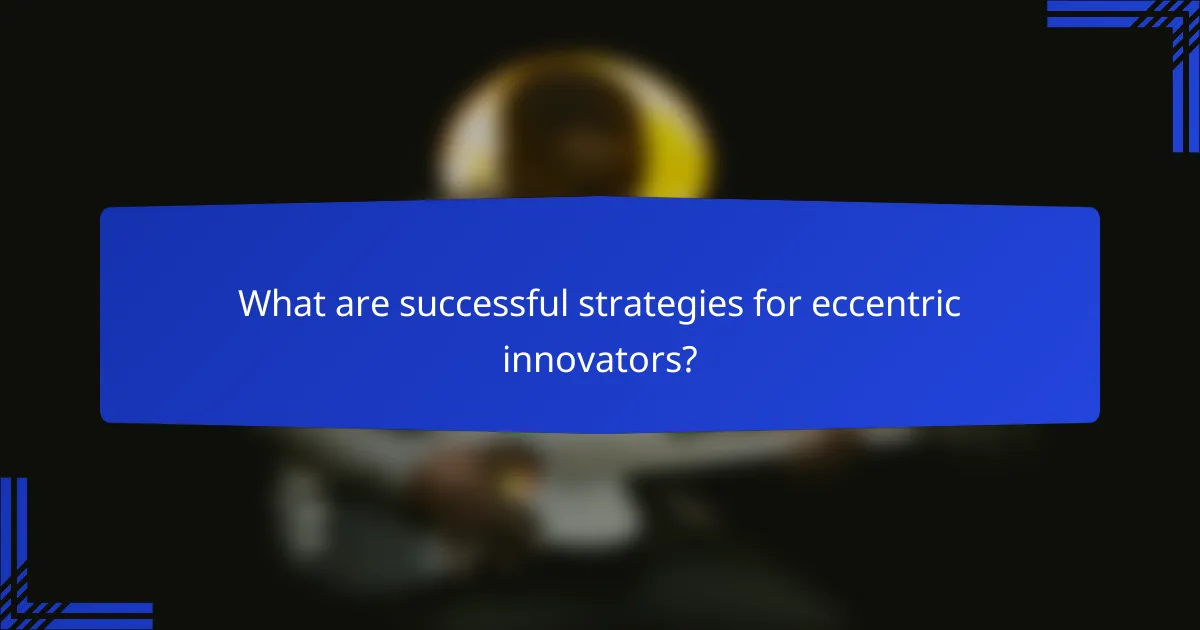Eccentric innovators often challenge the status quo with their unconventional ideas, facing skepticism and significant barriers along the way. By building credibility and engaging with communities, they can showcase their successes and gain the support needed to thrive. Strategies such as leveraging crowdfunding and developing strong networks are essential for overcoming obstacles and achieving their goals.

How do eccentric innovators overcome skepticism in Canada?
Eccentric innovators in Canada often face skepticism due to their unconventional ideas. They overcome this by building credibility, engaging with communities, and showcasing their successes to gain acceptance and support.
Building a strong personal brand
Establishing a strong personal brand is crucial for eccentric innovators. This involves clearly communicating their unique vision and values through various platforms, such as social media, public speaking, and personal websites. A well-defined brand helps to differentiate them from traditional innovators and fosters trust among potential supporters.
Innovators should focus on authenticity and consistency in their messaging. Sharing personal stories and experiences can resonate with audiences, making their ideas more relatable and compelling.
Engaging with communities
Engaging with local communities is essential for gaining support and reducing skepticism. Innovators can participate in community events, workshops, or forums to share their ideas and receive feedback. This interaction not only builds relationships but also allows innovators to understand the concerns and interests of their audience.
Collaborating with local organizations or influencers can amplify their reach and credibility. By aligning their projects with community values, innovators can foster a sense of ownership and enthusiasm among potential supporters.
Leveraging social proof
Social proof is a powerful tool for eccentric innovators to counter skepticism. This can include testimonials, endorsements, or case studies that highlight the success of their ideas. By showcasing how their innovations have positively impacted others, they can build trust and credibility.
Innovators should actively seek out partnerships with reputable organizations or individuals who can vouch for their work. Sharing success stories through media coverage or social platforms can further enhance their visibility and acceptance in the market.

What barriers do eccentric innovators face?
Eccentric innovators often encounter significant barriers that can impede their progress, including funding challenges, market acceptance issues, and regulatory hurdles. These obstacles can vary in severity and impact, making it crucial for innovators to develop strategies to navigate them effectively.
Funding challenges
Securing funding is a primary hurdle for eccentric innovators, as traditional investors may be hesitant to back unconventional ideas. Many innovators find themselves relying on personal savings, crowdfunding, or niche investors who appreciate their unique vision.
To improve funding prospects, innovators should create a compelling business plan that clearly outlines their vision, potential market, and financial projections. Networking within industry-specific circles can also help connect with investors who are more open to unconventional projects.
Market acceptance issues
Market acceptance is another significant barrier, as consumers may be resistant to new ideas that challenge the status quo. Eccentric innovators must often invest time in educating potential customers about the benefits and uses of their innovations.
Conducting market research to understand consumer perceptions can help innovators tailor their messaging. Engaging in pilot programs or offering free trials can also facilitate acceptance by allowing consumers to experience the innovation firsthand.
Regulatory hurdles
Regulatory hurdles can pose serious challenges for eccentric innovators, particularly in heavily regulated industries such as healthcare or technology. Navigating the complex landscape of laws and regulations can be daunting and may require significant resources.
Innovators should familiarize themselves with relevant regulations early in the development process. Consulting with legal experts and industry professionals can provide valuable insights and help ensure compliance, ultimately streamlining the path to market.

What are successful strategies for eccentric innovators?
Successful strategies for eccentric innovators include building strong networks, leveraging crowdfunding, and adopting agile methodologies. These approaches help innovators navigate skepticism, secure funding, and adapt quickly to market changes.
Networking with industry leaders
Networking with industry leaders is crucial for eccentric innovators to gain credibility and access valuable resources. Building relationships with established professionals can lead to mentorship opportunities, partnerships, and insights into industry trends.
To effectively network, attend industry conferences, workshops, and seminars. Engage in conversations, share your ideas, and follow up with contacts to maintain relationships. Utilize platforms like LinkedIn to connect with leaders and showcase your work.
Utilizing crowdfunding platforms
Crowdfunding platforms provide a viable way for eccentric innovators to raise funds while validating their ideas. By presenting projects on sites like Kickstarter or Indiegogo, innovators can attract backers who believe in their vision.
When using crowdfunding, create a compelling pitch that clearly outlines the project’s value and potential impact. Set realistic funding goals and offer attractive rewards to entice backers. Be prepared for ongoing communication and updates throughout the campaign to maintain supporter engagement.
Adopting agile methodologies
Adopting agile methodologies allows eccentric innovators to respond quickly to feedback and market demands. This iterative approach emphasizes flexibility, enabling innovators to make adjustments based on user input and testing results.
To implement agile practices, break projects into smaller tasks and set short development cycles, known as sprints. Regularly review progress and adapt plans as necessary. This method not only enhances product quality but also fosters a culture of continuous improvement and innovation.

Who are notable eccentric innovators in Canada?
Notable eccentric innovators in Canada are individuals who challenge conventional thinking and create groundbreaking solutions in various industries. They often face skepticism but leverage their unique perspectives to drive significant change and success.
Tobias Lütke (Shopify)
Tobias Lütke, the co-founder and CEO of Shopify, transformed the e-commerce landscape by enabling small businesses to easily set up online stores. His vision was to empower entrepreneurs, which led to Shopify becoming a leading platform for over a million businesses worldwide.
Lütke’s approach emphasizes simplicity and user-friendliness, allowing merchants to focus on their products rather than technical complexities. This has made Shopify a go-to solution for many startups and small enterprises in Canada and beyond.
Elon Musk (SpaceX, Tesla)
Although primarily known for his ventures in the United States, Elon Musk’s influence extends to Canada through his innovative companies like Tesla and SpaceX. Musk’s eccentric approach to technology and sustainability has reshaped industries, pushing the boundaries of electric vehicles and space exploration.
Michelle Romanow (Clearbanc)
Michelle Romanow, co-founder of Clearbanc, revolutionized funding for startups by offering revenue-based financing. This model allows businesses to access capital without giving up equity, which is particularly appealing to entrepreneurs looking to maintain control over their companies.

What role does mentorship play in innovation?
Mentorship plays a crucial role in innovation by providing guidance, support, and valuable connections that can help innovators navigate challenges and enhance their ideas. A mentor can offer insights based on experience, helping to refine concepts and avoid common pitfalls.
Guidance through challenges
Mentors help innovators face various challenges by sharing their experiences and strategies for overcoming obstacles. For instance, a mentor might advise on how to pivot a business model when initial ideas do not resonate with the market. This guidance can be vital in maintaining momentum and focus during difficult times.
Additionally, mentors can assist in identifying potential risks and developing contingency plans, ensuring that innovators are better prepared for setbacks. Their perspective can help innovators think critically about their approach and make informed decisions.
Access to resources and networks
Mentorship often opens doors to valuable resources and networks that are essential for innovation. A mentor may introduce an innovator to industry contacts, potential investors, or collaborators who can provide support and funding. This access can significantly enhance the chances of success.
Moreover, mentors can guide innovators in leveraging available resources, such as grants, incubators, or workshops, which can provide additional support in the innovation process. Understanding where to find these resources is crucial for turning ideas into reality.
Encouragement and motivation
Encouragement from a mentor can be a powerful motivator for innovators facing skepticism. A mentor’s belief in an innovator’s potential can instill confidence, helping them to persevere despite challenges. This emotional support is often as important as practical advice.
Furthermore, mentors can help innovators set realistic goals and celebrate milestones, reinforcing a sense of achievement and progress. Regular check-ins and feedback can keep innovators accountable and motivated to continue their journey toward success.

How can innovators measure their success?
Innovators can measure their success by evaluating specific metrics that reflect their goals and impact. This involves tracking progress against defined objectives, assessing customer feedback, and analyzing market performance.
Tracking key performance indicators
Key performance indicators (KPIs) are essential for innovators to gauge their success effectively. These metrics should align with the innovator’s objectives, whether that’s revenue growth, user engagement, or market share. Common KPIs include sales figures, customer acquisition costs, and user retention rates.
When selecting KPIs, consider both quantitative and qualitative measures. For example, while sales growth can provide clear numerical data, customer satisfaction surveys can offer insights into user experience. Balancing these types of indicators can provide a comprehensive view of success.
To avoid common pitfalls, ensure that KPIs are realistic and achievable. Setting overly ambitious targets can lead to frustration and misalignment. Regularly review and adjust KPIs to reflect changes in the market or business strategy, ensuring they remain relevant and actionable.
